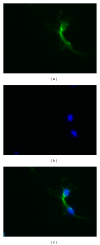The effects of acupuncture on bladder interstitial cells of cajal excitability in rats with overactive bladder
- PMID: 24194780
- PMCID: PMC3806234
- DOI: 10.1155/2013/261217
The effects of acupuncture on bladder interstitial cells of cajal excitability in rats with overactive bladder
Abstract
It is well known that acupuncture treatment has an effect on patients with an overactive bladder, but the mechanism of its action remains to be clarified. This study was aimed to investigate the effects of acupuncture on bladder overactivity, and the excitability of interstitial cells of Cajal of the bladder in a rat model of partial bladder outlet obstruction. Electroacupuncture (continuous wave, 30 Hz, 1 mA) was applied to stimulate the Ciliao point (BL32) and the Huiyang point (BL35) of rats for 20 min, 3 days. Results showed that acupuncture suppressed detrusor unstable contraction frequency and decreased detrusor maximum pressure in the bladder filling period. Compared with the normal control rats, HCN2 mRNA and protein expression within the bladder were upregulated and were reversed by electroacupuncture in overactive bladder rats as determined by RT-PCR, western blotting and immunohistochemistry. Moreover, in-vitro cell-cultured OAB rats bladder interstitial cells of Cajal intracellular Ca(2+) concentration were higher than normal control rats, which were lowered after acupuncture treatment. These findings suggest that acupuncture stimulation can suppress bladder overactivity, and regulate the excitability of bladder interstitial cells of Cajal in treatment of overactive bladder myogenic mechanism.
Figures










Similar articles
-
Electroacupuncture Alleviates Bladder Overactivity via Inhabiting Bladder P2X3 Receptor.Evid Based Complement Alternat Med. 2020 Mar 16;2020:4080891. doi: 10.1155/2020/4080891. eCollection 2020. Evid Based Complement Alternat Med. 2020. PMID: 32256644 Free PMC article.
-
Electroacupuncture at points Baliao and Huiyang (BL35) for post-stroke detrusor overactivity.Neural Regen Res. 2013 Jun 25;8(18):1663-72. doi: 10.3969/j.issn.1673-5374.2013.18.004. Neural Regen Res. 2013. PMID: 25206463 Free PMC article.
-
Changes in hyperpolarization-activated cyclic nucleotide-gated channel expression and activity in bladder interstitial cells of Cajal from rats with detrusor overactivity.Int Urogynecol J. 2015 Aug;26(8):1139-45. doi: 10.1007/s00192-015-2632-x. Epub 2015 Feb 13. Int Urogynecol J. 2015. PMID: 25677606
-
Cajal-like interstitial cells as a novel target in detrusor overactivity treatment: true or myth?Cent European J Urol. 2014;66(4):413-7. doi: 10.5173/ceju.2013.04.art5. Epub 2014 Jan 27. Cent European J Urol. 2014. PMID: 24757530 Free PMC article. Review.
-
The telocytes/myofibroblasts 3-D network forms a stretch receptor in the human bladder mucosa. Is this structure involved in the detrusor overactive diseases?Ann Anat. 2018 Jul;218:118-123. doi: 10.1016/j.aanat.2018.01.009. Epub 2018 Apr 11. Ann Anat. 2018. PMID: 29654819 Review.
Cited by
-
Effect of Electroacupuncture on Bladder Dysfunction via Regulation of MLC and MLCK Phosphorylation in a Rat Model of Type 2 Diabetes Mellitus.Evid Based Complement Alternat Med. 2021 Jun 10;2021:5558890. doi: 10.1155/2021/5558890. eCollection 2021. Evid Based Complement Alternat Med. 2021. PMID: 34221075 Free PMC article.
-
Electroacupuncture Alleviates Bladder Overactivity via Inhabiting Bladder P2X3 Receptor.Evid Based Complement Alternat Med. 2020 Mar 16;2020:4080891. doi: 10.1155/2020/4080891. eCollection 2020. Evid Based Complement Alternat Med. 2020. PMID: 32256644 Free PMC article.
-
Effects of electroacupuncture on bladder dysfunction and the expression of PACAP38 in a diabetic rat model.Front Physiol. 2023 Jan 9;13:1008269. doi: 10.3389/fphys.2022.1008269. eCollection 2022. Front Physiol. 2023. PMID: 36699677 Free PMC article.
-
Acupuncture for Women with Overactive Bladder: Perspective of Traditional Chinese Medicine and Related Mechanism.Int J Gen Med. 2023 Mar 28;16:1137-1148. doi: 10.2147/IJGM.S406194. eCollection 2023. Int J Gen Med. 2023. PMID: 37013136 Free PMC article. Review.
-
Electroacupuncture improves cyclophosphamide-induced bladder overactivity by reducing mechanotransduction in the rat urothelium.J Tradit Chin Med. 2025 Apr;45(2):348-358. doi: 10.19852/j.cnki.jtcm.2025.02.003. J Tradit Chin Med. 2025. PMID: 40151121 Free PMC article.
References
-
- Tanaka Y, Koyama Y, Jodo E, et al. Effects of acupuncture to the sacral segment on the bladder activity and electroencephalogram. Psychiatry and Clinical Neurosciences. 2002;56(3):249–250. - PubMed
-
- Hino K, Honjo H, Nakao M, Kitakoji H. The effects of sacral acupuncture on acetic acid-induced bladder irritation in conscious rats. Urology. 2010;75(3):730–734. - PubMed
-
- Wang H, Tanaka Y, Kawauchi A, Miki T, Kayama Y, Koyama Y. Acupuncture of the sacral vertebrae suppresses bladder activity and bladder activity-related neurons in the brainstem micturition center. Neuroscience Research. 2012;72(1):43–49. - PubMed
-
- Tjon Eng Soe SH, Kopsky DJ, Jongen PJH, de Vet HCW, Oei-Tan CL. Multiple sclerosis patients with bladder dysfunction have decreased symptoms after electro-acupuncture. Multiple Sclerosis. 2009;15(11):1376–1377. - PubMed
-
- Kitakoji H, Terasaki T, Honjo H, et al. Effect of acupuncture on the overactive bladder. Japanese Journal of Urology. 1995;86(10):1514–1519. - PubMed
LinkOut - more resources
Full Text Sources
Other Literature Sources
Miscellaneous

